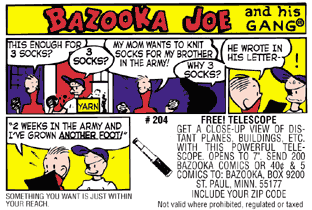Bazooka Joe

Bazooka Joe is a comic strip character featured on small comics included in individually wrapped pieces of Bazooka bubble gum. He wears a black eyepatch, lending him a distinctive appearance. He is one of the more recognizable American advertising characters of the 20th century, due to worldwide distribution, and one of the few associated with a candy.
Characters and story[edit]
Bazooka Joe is joined in his various misadventures by a motley crew of characters, who came from the tradition of syndicated kid gang comic strips such as Gene Byrnes' Reg'lar Fellers and Ad Carter's Just Kids. The group includes:
- Pesty (formerly Orville), Joe's younger brother, with a 1950s cowboy sombrero
- Mort, a gangly boy who always wears his red turtleneck sweater pulled up over his mouth[1]
- Hungry Herman, Joe's tubby pal
- Jane, Joe's girlfriend
- Tuffy, a streetwise type who wears a sailor hat
- Walkie Talkie, a neighborhood mutt
The comics generally consist of soft, child-friendly jokes, as well as small advertisements for kitschy merchandise one could obtain in exchange for comics and a few cents or dollars. From the very beginning in 1954, the bottom of the comics included "fortunes" similar to those one would find in a fortune cookie, sometimes with a comedic bent.
Development[edit]
Sometime between 1952 and 1954, Woody Gelman and Ben Solomon, heads of Product Development at Topps,[2] approached cartoonist Wesley Morse to create Bazooka Joe and his Gang. The character was named after a contest was held asking for suggestions.[3]
In Heroes of the Comics: Portraits of the Pioneering Legends of Comic Books, Drew Friedman wrote: "Gelman, along with his friend and former co-animator Ben Solomon, created Popsicle Pete, who appeared in ads and packages for Popsicle ice pops for decades. Popsicle Pete caught the eye of president of the Topps Company, Arthur Shorin, who hired Gelman and Solomon to work for him full time in Brooklyn. Gelman worked as an editor and writer for Topps, and Solomon became its art director. Gelman soon became head of the new product development department, where he developed the Bazooka Joe mini-comics (drawn by Wesley Morse) and had his hand in many successful innovations for trading cards and other products."[4]
Bazooka Joe's style changed with the times, as with almost all 20th-century advertising characters with any sort of longevity. By the 1990s, Joe had adopted a more contemporary look, including low-slung, baggy jeans.
From 1967 to 1990, the main writer was cartoonist Jay Lynch.[5]
Bazooka Joe comics were localized or translated for sale in other countries. For example, the Canadian version featured bilingual (simultaneous English and French) text balloons.
References[edit]
- ^ Dotz, Warren; Morton, Jim (1996). What a Character! 20th Century American Advertising Icons. Chronicle Books. p. 13. ISBN 0-8118-0936-6.
- ^ Mint Condition: How Baseball Cards Became an American Obsession, p. 117, Dave Jamieson, 2010, Atlantic Monthly Press, imprint of Grove/Atlantic Inc., New York, NY, ISBN 978-0-8021-1939-1
- ^ "LILEKS".
- ^ Friedman, Drew (2014). Heroes of the Comics: Portraits of the Pioneering Legends of Comic Books. Fantagraphics Books. ISBN 1606997319.
- ^ Gene Weingarten (November 20, 2012). "Chewish Humor". Washington Post Magazine. Retrieved December 3, 2012.
External links[edit]
- 1954 comics debuts
- 2012 comics endings
- American comics characters
- Chewing gum
- Comics about children
- Child characters in comics
- Comics characters introduced in 1954
- Mascots introduced in 1954
- Food advertising characters
- Gag-a-day comics
- Male characters in comics
- Male characters in advertising
- Child characters in advertising
- Fictional characters missing an eye
- Topps franchises
- Fictional eyepatch wearers
